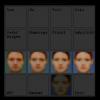Stefan Maskiewicz’s dialogic hypertext Quadrego was written for and awarded the First Prize at the 2001 literatur.digital competition, organized and funded by T-Online and the Deutscher Taschenbuchverlag (dtv). It was created for the Internet using HTML and JavaScript. The narrative embarks on a journey through the mentally diseased consciousness of a homodiegetic unreliable narrator.
Maskiewicz explores the mental condition of a girl suffering from MPD (Multiple Personality Disorder). His major innovation lies in the exploration of hypertextual reading strategies so as to make them resemble the rituality of competing voices and identities within one mind, a type of multiple schizophrenia. The GUI serves as a two-dimensional stage for the four egos ("Quadr-ego"), who are engaged in an argument. The reader activates the conversational turns via mouseclick. Whereas some responses seem to refer clearly to what was said directly before, others seem to be uttered incoherently. The resulting mix of sense and non-sense, of logic and irrationality, is intended by the author to convey a maximally authentic picture of the symptoms of MPD.
Maskiewicz opens his hypertext with a prologue that, due to its both tragic and topical outlook, invariably attracts the reader’s interest. It introduces "a little girl who learns to live under her brother’s brutality and dominance. But one day she realizes that she can free herself. The path to liberation is impeded by her brother’s violence and her love for him. Her conscience starts taking possession of her. [start; my translation]." The hypertext "starts" (there is only one possible path at the beginning) by revealing Iris’s alias No’s (the name the girl chooses for herself) desperate interior monologue, which has an arresting effect on readers, making them want to read on.
- ... and suddenly they were there. They appeared out of the darkness of her tainted soul. They came without a warning and settled down—in her head—and became louder. A deplorable state. Forced into a corner of her own mind, crouched, freezing and ... [start; my translation]
What follows is a convoluted, multiple dialogue between No’s internal voices, whom she gives the names of her abusive brother (Tom), her friends Iris and Rolf, and her own. The "characters" in her psychodrama express their opinions about each other and, in the "Quadrego" lexia, embark on a discussion which resembles the partially disjointed conversation fragments of a chatroom. The climactic reading process moves towards the absorption of the reader into the hypertext. As No becomes increasingly entangled with her own schizophrenic conflict, she "invents" a new identity, Georg, who operates as the reader’s mouthpiece. This unexpected turn of the "story" is tantalizing for the reader who increasingly identifies with, but at the same time tries to escape from, No’s psychosis. It comes as a relief to choose the link "MPD," which gives a sobering, demystifying turn to the otherwise alarming development of the reading experience.
Aesthetically, Quadrego owes its major visual appeal to Maskiewicz’s artistic skill. The writer, who is a practicing visual artist and lecturer in fine arts, makes it clear that in his hypermedia art work, pictographic imagery is of prime importance. Content is paralleled in formal intricacy and an elaborate linking pattern which clearly symbolizes No’s psychotic condition. An element of semiotic complement between writing and pictorial representation is Iris’s—a telling name—changing eye color, which iconically reflects her shifting identities. Paralleling the turns of voices, the contorted, colorful photographic images of the four egos change their eye color at regular intervals, thus enhancing the effect of random personality transitions. The visual effect is such that the portraits seem to smoothly undergo gender transformations as the reader’s eye wanders along them. As a matter of fact, all portraits are based on one picture of the author himself, which Maskiewicz has modified to represent female, male or hybrid gender features.
Quadrego has been widely discussed and analyzed by critics such as Roberto Simanowski (2001a/b). For a recent publication on unreliable narration in Quadrego, see Ensslin (forthcoming).
The entry has been adapted from A. Ensslin (2007) Canonizing Hypertext: Explorations and Constructions. London: Continuum, pp. 99-100.
Works cited:
- Ensslin, Astrid (forthcoming, 2011) '“I Want to Say I May Have Seen My Son Die This Morning”: Unintentional Unreliable Narration in Digital Fiction. Language and Literature.
- Simanowski, R. (2001a), "Multiple Personality Disorder als Bildschirmkombination." dichtung-digital. Available at: http://www.brown.edu/Research/dichtung-digital/2001/11/30-Reviews/quadre... [Accessed 18 May 2010].
- Simanowski, R. (2001b), "Interview with Stefan Maskiewicz." Dichtung-digital. Available at: www.dichtung-digital.com/2001/11/30-Wettbewerb/maskiewicz.htm [Accessed 20 August 2006].

